

Compact Muon Solenoid
LHC, CERN
| CMS-EXO-18-011 ; CERN-EP-2019-141 | ||
| Search for dark matter particles produced in association with a Higgs boson in proton-proton collisions at $\sqrt{s} = $ 13 TeV | ||
| CMS Collaboration | ||
| 5 August 2019 | ||
| JHEP 03 (2020) 025 | ||
| Abstract: A search for dark matter (DM) particles is performed using events with a Higgs boson candidate and large missing transverse momentum. The analysis is based on proton-proton collision data at a center-of-mass energy of 13 TeV collected by the CMS experiment at the LHC in 2016, corresponding to an integrated luminosity of 35.9 fb$^{-1}$. The search is performed in five Higgs boson decay channels: $\mathrm{h} \to \mathrm{b\bar{b}}$, $\gamma\gamma$, $\tau^{+}\tau^{-}$, $\mathrm{W}^{+}\mathrm{W}^{-}$, and $\mathrm{Z}\mathrm{Z}$ and the results from the individual channels are combined to maximize the sensitivity of the analysis. No significant excess over the expected standard model background is observed in any of the five channels or in their combination. Limits are set on DM production in the context of two simplified models. The results are also interpreted in terms of a spin-independent DM-nucleon scattering cross section and compared to those from direct-detection DM experiments. This is the first search for DM particles produced in association with a Higgs boson decaying to a pair of W or Z bosons, and the first statistical combination based on five Higgs boson decay channels. | ||
| Links: e-print arXiv:1908.01713 [hep-ex] (PDF) ; CDS record ; inSPIRE record ; CADI line (restricted) ; | ||
| Figures | |
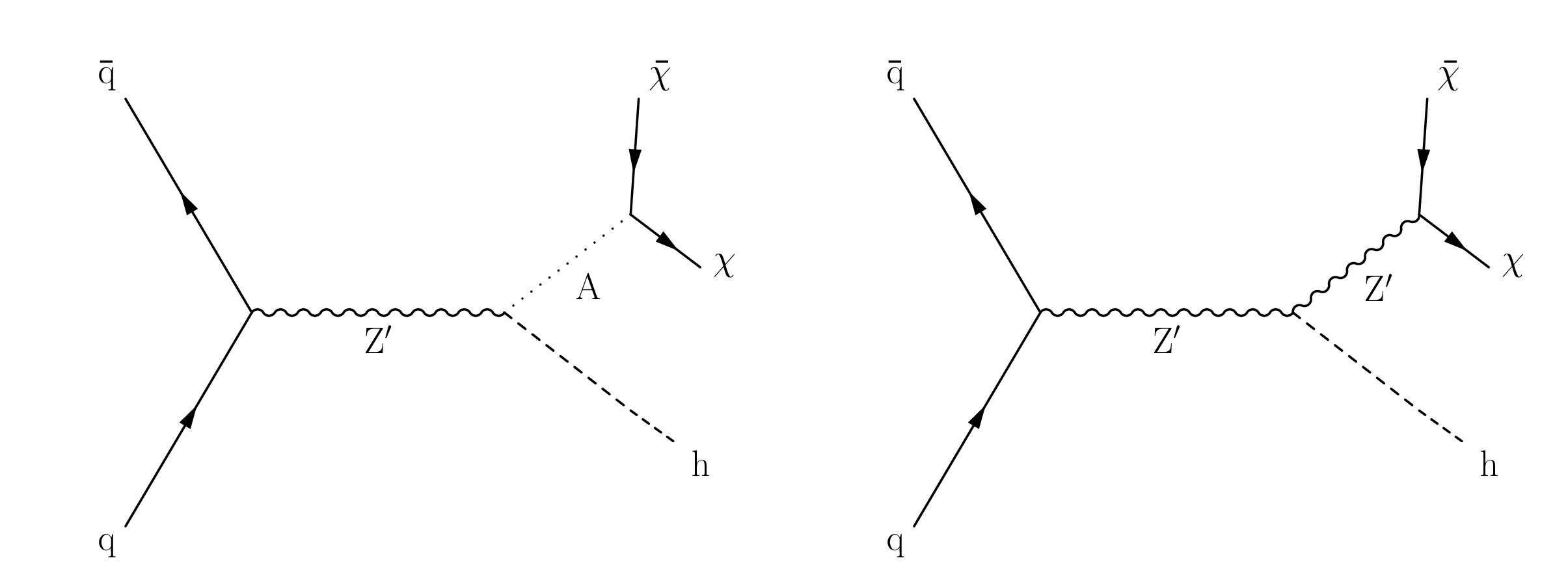
png pdf |
Figure 1:
Representative Feynman diagrams for the two benchmark signal models considered in this paper: the Z'-2HDM (left) and the baryonic Z' model (right). |

png pdf |
Figure 1-a:
Representative Feynman diagram for the Z'-2HDM signal model. |

png pdf |
Figure 1-b:
Representative Feynman diagram for the baryonic Z' signal model. |

png pdf |
Figure 2:
The distribution of ${{p_{\mathrm {T}}} ^\text {miss}}$ at the generator level for the Z'-2HDM (left), showing the dependence on the two main model parameters varied in the analysis, ${m_{\mathrm{Z'}}}$ and ${m_{\mathrm{A} }}$, and for the baryonic Z' model (right), showing the variation of ${{p_{\mathrm {T}}} ^\text {miss}}$ as a function of ${m_{\mathrm{Z'}}}$ and ${m_\chi}$. All other parameters of the models are fixed to the values specified in the text. The distributions are normalized to unit area. |
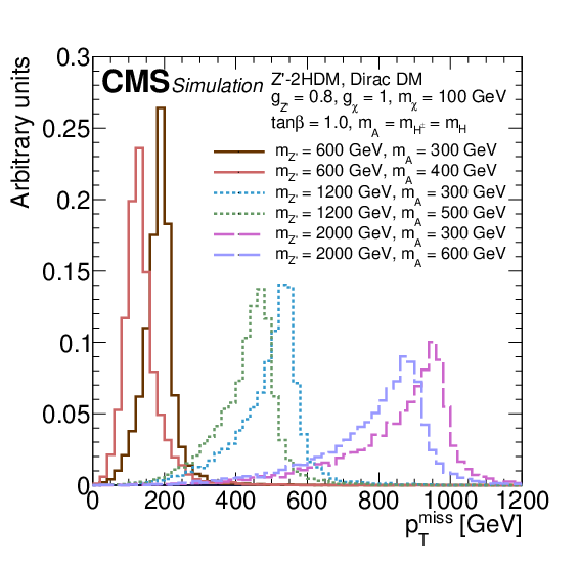
png pdf |
Figure 2-a:
The distribution of ${{p_{\mathrm {T}}} ^\text {miss}}$ at the generator level for the Z'-2HDM, showing the dependence on the two main model parameters varied in the analysis, ${m_{\mathrm{Z'}}}$ and ${m_{\mathrm{A} }}$. All other parameters of the model are fixed to the values specified in the text. The distributions are normalized to unit area. |
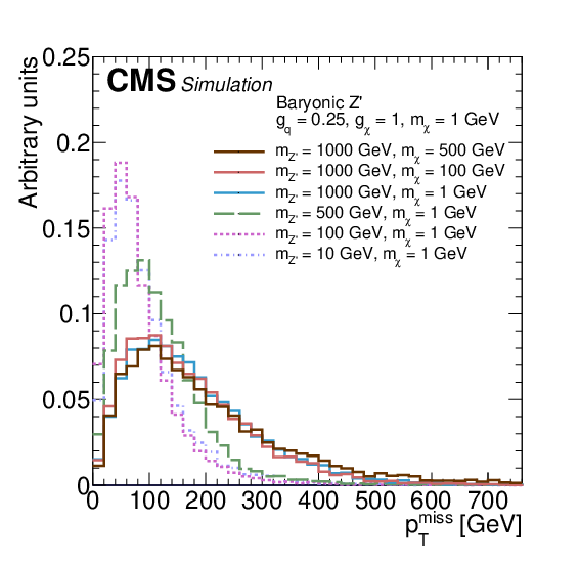
png pdf |
Figure 2-b:
The distribution of ${{p_{\mathrm {T}}} ^\text {miss}}$ at the generator level for the baryonic Z' model, showing the variation of ${{p_{\mathrm {T}}} ^\text {miss}}$ as a function of ${m_{\mathrm{Z'}}}$ and ${m_\chi}$. All other parameters of the model are fixed to the values specified in the text. The distributions are normalized to unit area. |
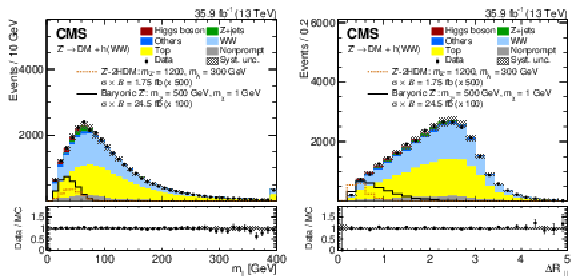
png pdf |
Figure 3:
The distribution of ${m_{{\ell} {\ell}}}$ (left) and ${\Delta R_{{\ell} {\ell}}}$ (right) after the preselection, expected from MC simulation (stacked histograms) and observed in data (points with vertical bars). The systematic uncertainties, discussed in Section 7.1, are shown by the hatched region. Two signal benchmarks, corresponding to the Z'-2HDM (dotted orange line) and baryonic Z' (solid black line) model are superimposed. The signal is normalized to the product of cross section and branching fraction, where $\mathcal {B}$ represents the $\mathrm{h} \to {\mathrm{W} \mathrm{W}} $ branching fraction. The lower panel shows the ratio of the data to the predicted SM background. |
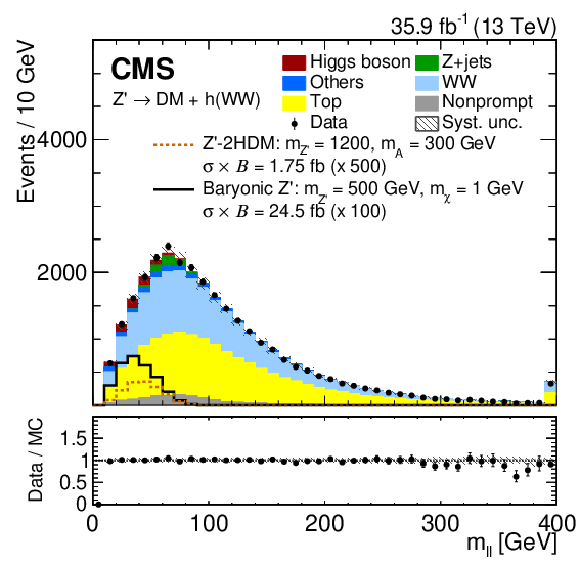
png pdf |
Figure 3-a:
The distribution of ${m_{{\ell} {\ell}}}$ after the preselection, expected from MC simulation (stacked histograms) and observed in data (points with vertical bars). The systematic uncertainties, discussed in Section 7.1, are shown by the hatched region. Two signal benchmarks, corresponding to the Z'-2HDM (dotted orange line) and baryonic Z' (solid black line) model are superimposed. The signal is normalized to the product of cross section and branching fraction, where $\mathcal {B}$ represents the $\mathrm{h} \to {\mathrm{W} \mathrm{W}} $ branching fraction. The lower panel shows the ratio of the data to the predicted SM background. |

png pdf |
Figure 3-b:
The distribution of ${\Delta R_{{\ell} {\ell}}}$ after the preselection, expected from MC simulation (stacked histograms) and observed in data (points with vertical bars). The systematic uncertainties, discussed in Section 7.1, are shown by the hatched region. Two signal benchmarks, corresponding to the Z'-2HDM (dotted orange line) and baryonic Z' (solid black line) model are superimposed. The signal is normalized to the product of cross section and branching fraction, where $\mathcal {B}$ represents the $\mathrm{h} \to {\mathrm{W} \mathrm{W}} $ branching fraction. The lower panel shows the ratio of the data to the predicted SM background. |

png pdf |
Figure 4:
The four-lepton invariant mass (left) and ${{p_{\mathrm {T}}} ^\text {miss}}$ distributions (right) after the preselection, expected from MC simulation (stacked histograms) and observed in data (points with vertical bars). The systematic uncertainties, discussed in Section 7.1, are shown by the hatched region. Two signal benchmarks, corresponding to the Z'-2HDM (dotted orange line) and baryonic Z' (solid black line) model are superimposed. The signal is normalized to the product of cross section and branching fraction, where $\mathcal {B}$ represents the $\mathrm{h} \to {\mathrm{Z} \mathrm{Z}} $ branching fraction. The lower panel shows the ratio of the data to the predicted SM background. |

png pdf |
Figure 4-a:
The four-lepton invariant mass distribution after the preselection, expected from MC simulation (stacked histograms) and observed in data (points with vertical bars). The systematic uncertainties, discussed in Section 7.1, are shown by the hatched region. Two signal benchmarks, corresponding to the Z'-2HDM (dotted orange line) and baryonic Z' (solid black line) model are superimposed. The signal is normalized to the product of cross section and branching fraction, where $\mathcal {B}$ represents the $\mathrm{h} \to {\mathrm{Z} \mathrm{Z}} $ branching fraction. The lower panel shows the ratio of the data to the predicted SM background. |
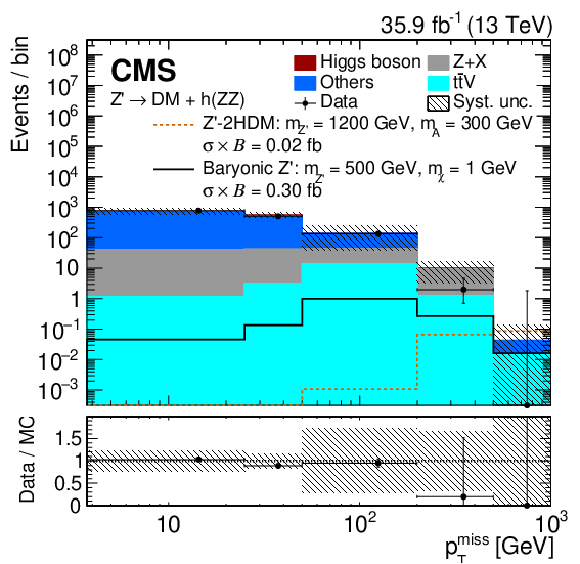
png pdf |
Figure 4-b:
The ${{p_{\mathrm {T}}} ^\text {miss}}$ distribution after the preselection, expected from MC simulation (stacked histograms) and observed in data (points with vertical bars). The systematic uncertainties, discussed in Section 7.1, are shown by the hatched region. Two signal benchmarks, corresponding to the Z'-2HDM (dotted orange line) and baryonic Z' (solid black line) model are superimposed. The signal is normalized to the product of cross section and branching fraction, where $\mathcal {B}$ represents the $\mathrm{h} \to {\mathrm{Z} \mathrm{Z}} $ branching fraction. The lower panel shows the ratio of the data to the predicted SM background. |
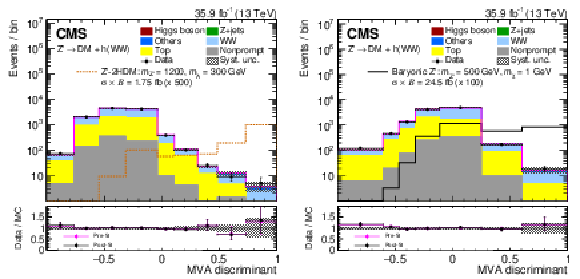
png pdf |
Figure 5:
The distribution of the BDT discriminants expected from MC simulation before and after the fit, and observed in data (points with errors) for the Z'-2HDM (left) and baryonic Z' (right) model in the signal region in the ${\mathrm{h} \to {\mathrm{W} \mathrm{W}}}$ analysis. Two signal benchmarks, corresponding to the Z'-2HDM (dotted orange line, left) and baryonic Z' (solid black line, right) model are superimposed. The signal is normalized to the product of cross section and branching fraction, where $\mathcal {B}$ represents the $\mathrm{h} \to {\mathrm{W} \mathrm{W}} $ branching fraction. The systematic uncertainties are shown by the hatched band. The lower panel shows the ratio of data to the total background yield, before and after the fit. |
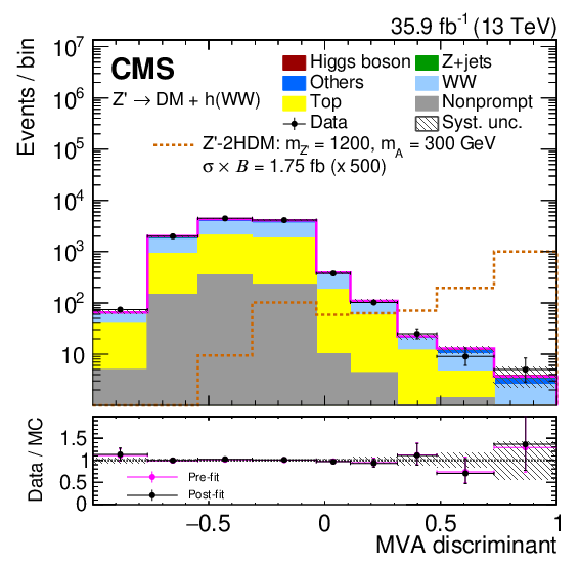
png pdf |
Figure 5-a:
The distribution of the BDT discriminants expected from MC simulation before and after the fit, and observed in data (points with errors) for the Z'-2HDM model in the signal region in the ${\mathrm{h} \to {\mathrm{W} \mathrm{W}}}$ analysis. The Z'-2HDM (dotted orange line) model is superimposed. The signal is normalized to the product of cross section and branching fraction, where $\mathcal {B}$ represents the $\mathrm{h} \to {\mathrm{W} \mathrm{W}} $ branching fraction. The systematic uncertainties are shown by the hatched band. The lower panel shows the ratio of data to the total background yield, before and after the fit. |
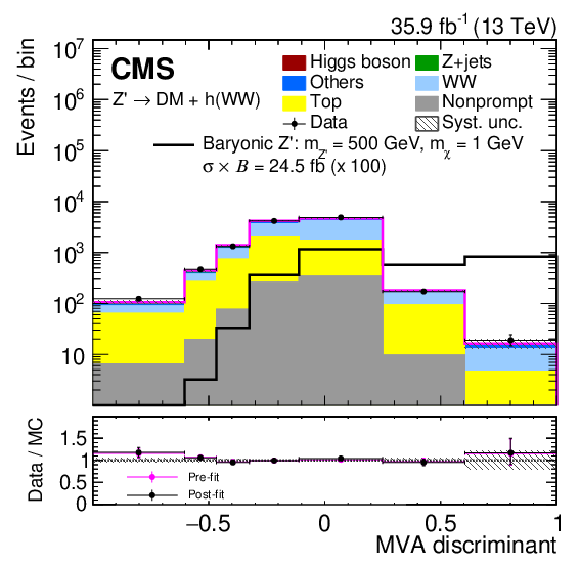
png pdf |
Figure 5-b:
The distribution of the BDT discriminants expected from MC simulation before and after the fit, and observed in data (points with errors) for the baryonic Z' model in the signal region in the ${\mathrm{h} \to {\mathrm{W} \mathrm{W}}}$ analysis. The baryonic Z' (solid black line) model is superimposed. The signal is normalized to the product of cross section and branching fraction, where $\mathcal {B}$ represents the $\mathrm{h} \to {\mathrm{W} \mathrm{W}} $ branching fraction. The systematic uncertainties are shown by the hatched band. The lower panel shows the ratio of data to the total background yield, before and after the fit. |

png pdf |
Figure 6:
The ${{p_{\mathrm {T}}} ^\text {miss}}$ distribution for the expected background and observed events in data in the ${\mathrm{h} \to \mathrm{Z} \mathrm{Z}}$ analysis. Two signal benchmarks, corresponding to the Z'-2HDM (dotted orange line, left) and baryonic Z' (solid black line, right) model are superimposed. The signal is normalized to the product of cross section and branching fraction, where $\mathcal {B}$ represents the $\mathrm{h} \to {\mathrm{Z} \mathrm{Z}} $ branching fraction. The systematic uncertainties are shown by the hatched band. The ratios of the data and the sum of all the SM backgrounds are shown in the bottom panels. |

png pdf |
Figure 7:
The upper limits at 95% CL on the observed and expected DM production cross section for the ${\mathrm{h} \to {\mathrm{W} \mathrm{W}}}$ (upper) and ${\mathrm{h} \to \mathrm{Z} \mathrm{Z}}$ (lower) analyses for the Z'-2HDM with $ {m_{\mathrm{A} }} = $ 300 GeV (left) and for the baryonic Z' with $ {m_\chi} = $ 1 GeV (right) model. The inner and outer shaded bands show the 68 and 95% uncertainties in the expected limit, respectively. |
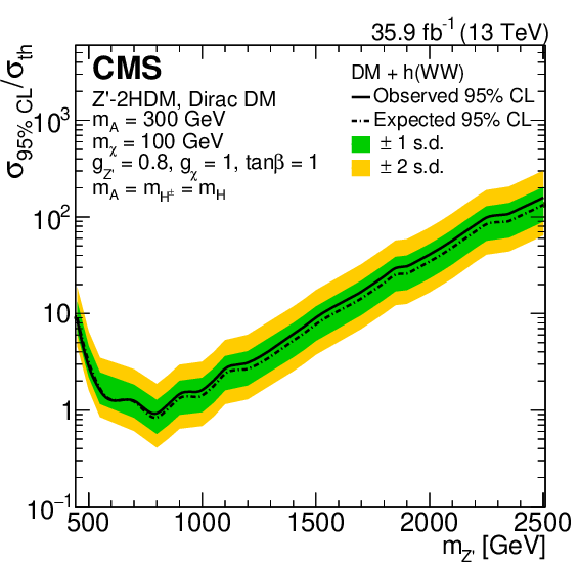
png pdf |
Figure 7-a:
The upper limits at 95% CL on the observed and expected DM production cross section for the ${\mathrm{h} \to {\mathrm{W} \mathrm{W}}}$ analysis for the Z'-2HDM with $ {m_{\mathrm{A} }} = $ 300 GeV model. The inner and outer shaded bands show the 68 and 95% uncertainties in the expected limit, respectively. |
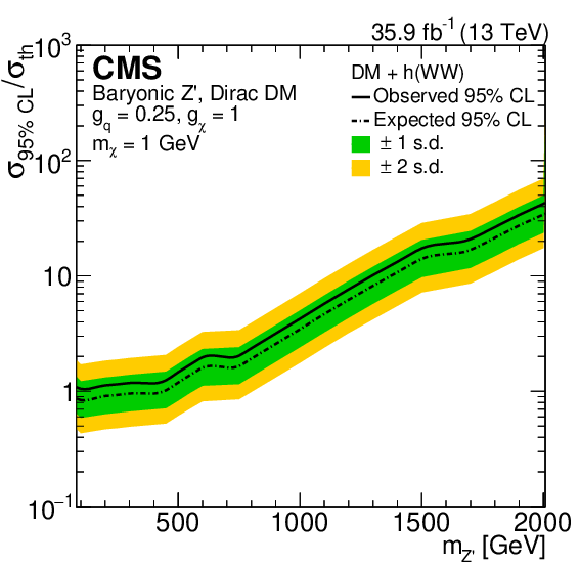
png pdf |
Figure 7-b:
The upper limits at 95% CL on the observed and expected DM production cross section for the ${\mathrm{h} \to {\mathrm{W} \mathrm{W}}}$ analysis for the baryonic Z' with $ {m_\chi} = $ 1 GeV model. The inner and outer shaded bands show the 68 and 95% uncertainties in the expected limit, respectively. |
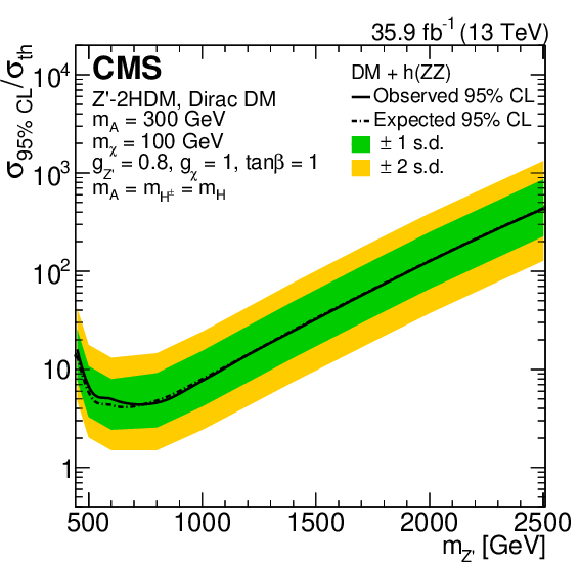
png pdf |
Figure 7-c:
The upper limits at 95% CL on the observed and expected DM production cross section for the ${\mathrm{h} \to \mathrm{Z} \mathrm{Z}}$ analysis for the Z'-2HDM with $ {m_{\mathrm{A} }} = $ 300 GeV model. The inner and outer shaded bands show the 68 and 95% uncertainties in the expected limit, respectively. |

png pdf |
Figure 7-d:
The upper limits at 95% CL on the observed and expected DM production cross section for the ${\mathrm{h} \to \mathrm{Z} \mathrm{Z}}$ analysis for the baryonic Z' with $ {m_\chi} = $ 1 GeV model. The inner and outer shaded bands show the 68 and 95% uncertainties in the expected limit, respectively. |

png pdf |
Figure 8:
The upper limits at 95% CL on the observed and expected $\sigma /\sigma _\text {th}$ for the Z'-2HDM (left) and baryonic Z' (right) model for the five individual decay modes of the Higgs boson, and for their combination. The distributions are shown as a function of ${m_{\mathrm{Z'}}}$ for $ {m_{\mathrm{A} }} = $ 300 GeV (Z'-2HDM) and $ {m_\chi} = $ 1 GeV (baryonic Z' model). The inner and outer shaded bands show the 68 and 95% CL uncertainties in the expected limit, respectively. |
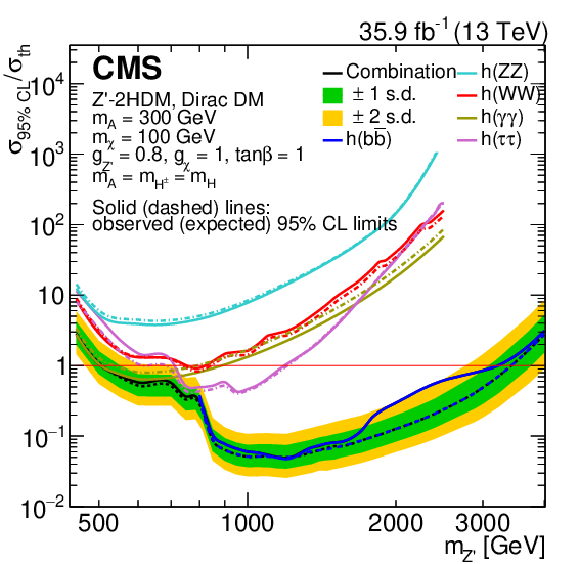
png pdf |
Figure 8-a:
The upper limits at 95% CL on the observed and expected $\sigma /\sigma _\text {th}$ for the Z'-2HDM model for the five individual decay modes of the Higgs boson, and for their combination. The distributions are shown as a function of ${m_{\mathrm{Z'}}}$ for $ {m_{\mathrm{A} }} = $ 300 GeV. The inner and outer shaded bands show the 68 and 95% CL uncertainties in the expected limit, respectively. |
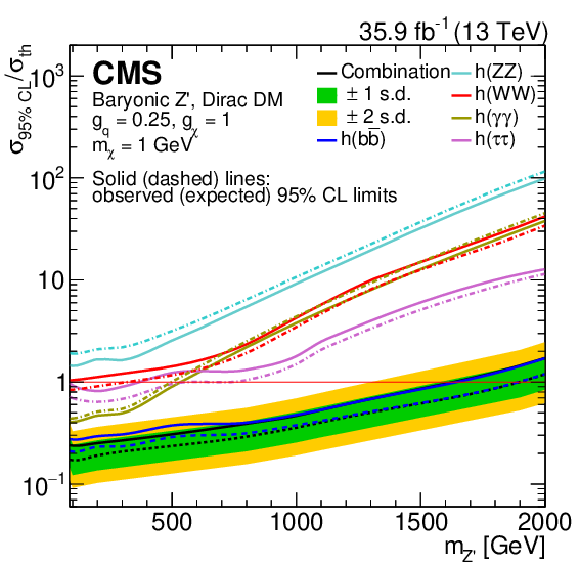
png pdf |
Figure 8-b:
The upper limits at 95% CL on the observed and expected $\sigma /\sigma _\text {th}$ for the baryonic Z' model for the five individual decay modes of the Higgs boson, and for their combination. The distributions are shown as a function of ${m_{\mathrm{Z'}}}$ for $ {m_\chi} = $ 1 GeV. The inner and outer shaded bands show the 68 and 95% CL uncertainties in the expected limit, respectively. |
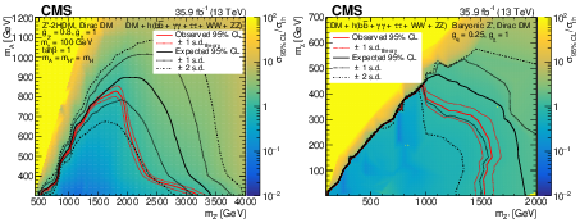
png pdf |
Figure 9:
The upper limits at 95% CL on the observed and expected $\sigma /\sigma _\text {th}$ in the ${m_{\mathrm{Z'}}} $-$ {m_{\mathrm{A} }}$ and ${m_{\mathrm{Z'}}} $-$ {m_\chi}$ planes for the Z'-2HDM (left) and baryonic Z' model (right), respectively. The region enclosed by the contours is excluded using the combination of the five decay channels of the Higgs boson for the following benchmark scenarios: $ {g_{\mathrm{Z'}}}= $ 0.8, $ {g_{\chi}}=$ 1, $\tan\beta =$ 1, $ {m_\chi} = $ 100 GeV, and $ {m_{\mathrm{A} }} = m_{\mathrm{H}} = m_{\mathrm{H} ^\pm}$ for the Z'-2HDM, and $ {g_{\chi}}=$ 1, $ {g_{\mathrm{q}}}= $ 0.25 for the baryonic Z' model. |
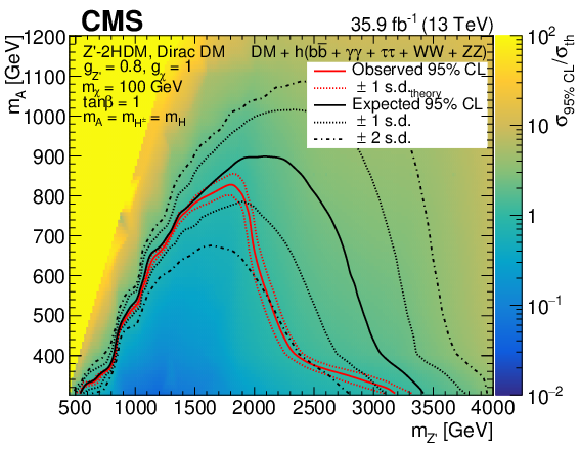
png pdf |
Figure 9-a:
The upper limits at 95% CL on the observed and expected $\sigma /\sigma _\text {th}$ in the ${m_{\mathrm{Z'}}} $-$ {m_{\mathrm{A} }}$ plane for the Z'-2HDM model. The region enclosed by the contours is excluded using the combination of the five decay channels of the Higgs boson for the following benchmark scenario: $ {g_{\mathrm{Z'}}}= $ 0.8, $ {g_{\chi}}=$ 1, $\tan\beta =$ 1, $ {m_\chi} = $ 100 GeV, and $ {m_{\mathrm{A} }} = m_{\mathrm{H}} = m_{\mathrm{H} ^\pm}$. |

png pdf |
Figure 9-b:
The upper limits at 95% CL on the observed and expected $\sigma /\sigma _\text {th}$ in the ${m_{\mathrm{Z'}}} $-$ {m_\chi}$ plane for the Z'-2HDM baryonic Z' model. The region enclosed by the contours is excluded using the combination of the five decay channels of the Higgs boson for the following benchmark scenario: $ {g_{\chi}}=$ 1, $ {g_{\mathrm{q}}}= $ 0.25. |
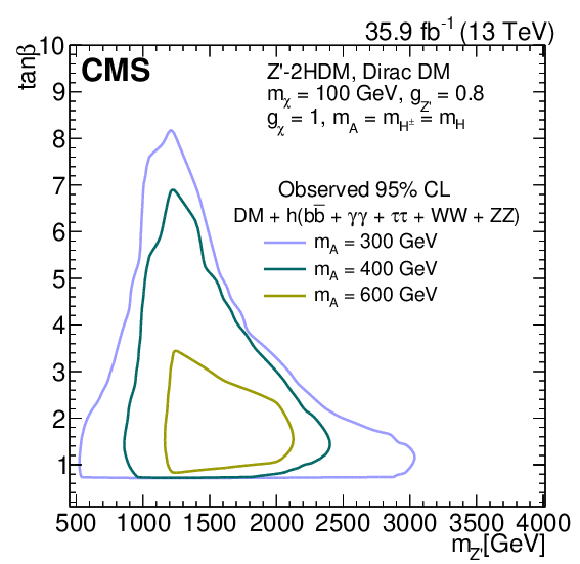
png pdf |
Figure 10:
The upper limits at 95% CL on the observed $\sigma /\sigma _\text {th}$ for the Z'-2HDM in the ${m_{\mathrm{Z'}}} $-$\tan\beta $ plane from the combination of the five Higgs boson decay channels. Each contour represents the excluded region for a given value of $ {m_{\mathrm{A} }} = $ 300, 400, and 600 GeV. |
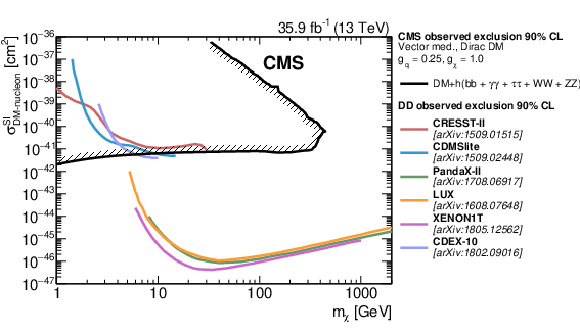
png pdf |
Figure 11:
The upper limits at 90% CL on the DM-nucleon spin-independent scattering cross section ${\sigma ^{\mathrm {SI}}}$, as a function of ${m_\chi}$. Results obtained in this analysis are compared with those from several direct-detection experiments: CRESST-II [96], CDMSLite [97], PandaX-II [98], LUX [99], XENON-1T [100], and CDEX-10 [101]. |
| Tables | |
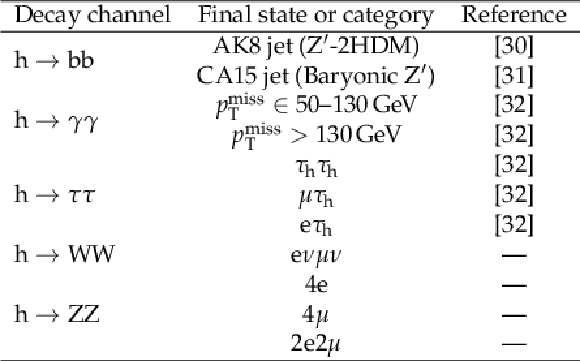
png pdf |
Table 1:
Summary of the individual channels entering the combination. Analyses are categorized based on the model, ${{p_{\mathrm {T}}} ^\text {miss}}$ selection, and subsequent decay products listed here. The categorization is the same for both the Z'-2HDM and the Baryonic Z' model for all decay channels except, as indicated, ${\mathrm{h} \to \mathrm{b} \mathrm{b}}$. A dash ("--") in the last column implies that the analysis is presented in this paper. |

png pdf |
Table 2:
Summary of the maximum number of additional objects allowed in an event for each analysis. A dash means that no restriction on the corresponding object is applied in the corresponding analysis. |
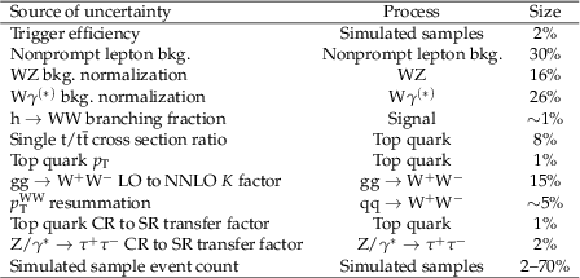
png pdf |
Table 3:
Systematic uncertainties affecting the ${\mathrm{h} \to {\mathrm{W} \mathrm{W}}}$ analysis. |
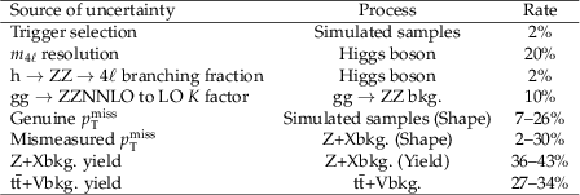
png pdf |
Table 4:
Systematic uncertainties affecting the ${\mathrm{h} \to \mathrm{Z} \mathrm{Z}}$ analysis. |

png pdf |
Table 5:
Systematic uncertainties in the combination of channels, along with the type (rate/shape) of uncertainty affecting signal and background processes, correlated amongst at least two final states. For the rate uncertainties, the percentage of the prior value is quoted, while for shape uncertainties an estimate of the impact of systematic uncertainties on the yield is also listed. A dash ("--'') implies that a given uncertainty does not affect the analysis. Whenever an uncertainty is present but kept uncorrelated in a particular channel, this is mentioned explicitly. The effect of the b jet mistag rate uncertainty is very small in the ${\mathrm{h} \to \mathrm{b} \mathrm{b}}$ Z'-2HDM analysis and hence it is added to the effect of the b tagging efficiency uncertainty in quadrature. |

png pdf |
Table 6:
The post-fit signal and background event yields, and the observed number of events in data, for the ${\mathrm{h} \to {\mathrm{W} \mathrm{W}}}$ analysis. The expected numbers of signal events for the two signal hypotheses are also reported, one for each benchmark model. The total uncertainty, including both statistical and systematic components, is quoted for the expected signal and backgrounds yields. |

png pdf |
Table 7:
The post-fit signal and background event yields, and the observed number of events in data, for the ${\mathrm{h} \to \mathrm{Z} \mathrm{Z}}$ analysis. The expected numbers of signal events for the two signal hypotheses are also reported, one for each benchmark model. The total uncertainty, including both statistical and systematic components, is quoted for the expected signal and backgrounds yields. |
| Summary |
| A search for dark matter particles produced in association with a Higgs boson has been presented, using a sample of proton-proton collision data at a center-of-mass energy of 13 TeV, corresponding to an integrated luminosity of 35.9 fb$^{-1}$. Results from five decay channels of the Higgs boson, $\mathrm{h} \to \mathrm{b\bar{b}}$, ${\mathrm{h} \to \gamma\gamma} $, and $\mathrm{h} \to \tau^{+}\tau^{-}$, $\mathrm{h} \to \mathrm{W}^{+} \mathrm{W}^{-}$ and $\mathrm{h} \to \mathrm{ZZ}$, are described, along with their statistical combination. No significant deviation from the standard model prediction is observed in any of the channels or in their combination. Upper limits at 95% confidence level on the production cross section of dark matter are set in a type-II two Higgs doublet model extended by a Z' boson and in a baryonic Z' model. The results in the baryonic Z' model are also interpreted in terms of the spin-independent dark matter nucleon scattering cross section. This is the first search for DM particles produced in association with a Higgs boson decaying to a pair of W or Z bosons, and the first statistical combination based on five Higgs boson decay channels. |
| References | ||||
| 1 | R. J. Gaitskell | Direct detection of dark matter | Ann. Rev. Nucl. Part. Sci. 54 (2004) 315 | |
| 2 | V. Trimble | Existence and nature of dark matter in the universe | Ann. Rev. Astron. Astrophys. 25 (1987) 425 | |
| 3 | T. A. Porter, R. P. Johnson, and P. W. Graham | Dark Matter searches with astroparticle data | Ann. Rev. Astron. Astrophys. 49 (2011) 155 | 1104.2836 |
| 4 | G. Bertone, D. Hooper, and J. Silk | Particle dark matter: evidence, candidates and constraints | PR 405 (2005) 279 | hep-ph/0404175 |
| 5 | Planck Collaboration | Planck 2018 results. I. Overview and the cosmological legacy of Planck | 1807.06205 | |
| 6 | J. L. Feng | Dark matter candidates from particle physics and methods of detection | Ann. Rev. Astron. Astrophys. 48 (2010) 495 | 1003.0904 |
| 7 | R. J. Scherrer and M. S. Turner | On the relic, cosmic abundance of stable weakly interacting massive particles | PRD 33 (1986) 1585 | |
| 8 | G. Steigman and M. S. Turner | Cosmological constraints on the properties of weakly interacting massive particles | NPB 253 (1985) 375 | |
| 9 | M. Beltran et al. | Maverick dark matter at colliders | JHEP 09 (2010) 037 | 1002.4137 |
| 10 | ATLAS Collaboration | Search for dark matter and other new phenomena in events with an energetic jet and large missing transverse momentum using the ATLAS detector | JHEP 01 (2018) 126 | 1711.03301 |
| 11 | CMS Collaboration | Search for new physics in final states with an energetic jet or a hadronically decaying $ \mathrm{W} $ or $ \mathrm{Z} $ boson and transverse momentum imbalance at $ \sqrt{s}=$ 13 TeV | PRD 97 (2018) 092005 | CMS-EXO-16-048 1712.02345 |
| 12 | ATLAS Collaboration | Search for dark matter produced in association with bottom or top quarks in $ \sqrt{s}= $ 13 TeV pp collisions with the ATLAS detector | EPJC 78 (2018) 18 | 1710.11412 |
| 13 | CMS Collaboration | Search for dark matter in events with energetic, hadronically decaying top quarks and missing transverse momentum at $ \sqrt{s}= $ 13 TeV | JHEP 06 (2018) 027 | CMS-EXO-16-051 1801.08427 |
| 14 | ATLAS Collaboration | Search for dark matter at $ \sqrt{s}= $ 13 TeV in final states containing an energetic photon and large missing transverse momentum with the ATLAS detector | EPJC 77 (2017) 393 | 1704.03848 |
| 15 | CMS Collaboration | Search for new physics in the monophoton final state in proton-proton collisions at $ \sqrt{s}= $ 13 TeV | JHEP 10 (2017) 073 | CMS-EXO-16-039 1706.03794 |
| 16 | ATLAS Collaboration | Search for an invisibly decaying Higgs boson or dark matter candidates produced in association with a $ Z $ boson in pp collisions at $ \sqrt{s} = $ 13 TeV with the ATLAS detector | PLB 776 (2018) 318 | 1708.09624 |
| 17 | CMS Collaboration | Search for new physics in events with a leptonically decaying Z boson and a large transverse momentum imbalance in proton-proton collisions at $ \sqrt{s} = $ 13 TeV | EPJC 78 (2018) 291 | CMS-EXO-16-052 1711.00431 |
| 18 | ATLAS Collaboration | Search for dark matter in events with a hadronically decaying vector boson and missing transverse momentum in pp collisions at $ \sqrt{s} = $ 13 TeV with the ATLAS detector | JHEP 10 (2018) 180 | 1807.11471 |
| 19 | ATLAS Collaboration | Observation of a new particle in the search for the standard model Higgs boson with the ATLAS detector at the LHC | PLB 716 (2012) 1 | 1207.7214 |
| 20 | CMS Collaboration | Observation of a new boson at a mass of 125 GeV with the CMS experiment at the LHC | PLB 716 (2012) 30 | CMS-HIG-12-028 1207.7235 |
| 21 | CMS Collaboration | Observation of a new boson with mass near 125 GeV in pp collisions at $ \sqrt{s} = $ 7 and 8 TeV | JHEP 06 (2013) 081 | CMS-HIG-12-036 1303.4571 |
| 22 | L. Carpenter et al. | Mono-Higgs-boson: a new collider probe of dark matter | PRD 89 (2014) 075017 | 1312.2592 |
| 23 | J. M. No | Looking through the pseudoscalar portal into dark matter: novel mono-Higgs and mono-Z signatures at the LHC | PRD 93 (2016) 031701 | 1509.01110 |
| 24 | ATLAS Collaboration | Search for dark matter in events with missing transverse momentum and a higgs boson decaying to two photons in pp collisions at $ \sqrt{s}= $ 8 TeV with the ATLAS detector | PRL 115 (2015) 131801 | 1506.01081 |
| 25 | ATLAS Collaboration | Search for dark matter produced in association with a Higgs boson decaying to two bottom quarks in pp collisions at $ \sqrt{s} = $ 8 TeV with the ATLAS detector | PRD 93 (2016) 072007 | 1510.06218 |
| 26 | ATLAS Collaboration | Search for dark matter in association with a Higgs boson decaying to b-quarks in pp collisions at $ \sqrt s= $ 13 TeV with the ATLAS detector | PLB 765 (2017) 11 | 1609.04572 |
| 27 | CMS Collaboration | Search for associated production of dark matter with a Higgs boson decaying to $ \mathrm{b}\overline{\mathrm{b}} $ or $ \gamma\gamma $ at $ \sqrt{s}= $ 13 TeV | JHEP 10 (2017) 180 | CMS-EXO-16-012 1703.05236 |
| 28 | ATLAS Collaboration | Search for dark matter in association with a Higgs boson decaying to two photons at $ \sqrt{s} = $ 13 TeV with the ATLAS detector | PRD 96 (2017) 112004 | 1706.03948 |
| 29 | ATLAS Collaboration | Search for dark matter produced in association with a Higgs boson decaying to $ b\bar b $ using 36 fb$ ^{-1} $ of pp collisions at $ \sqrt s= $ 13 TeV with the ATLAS detector | PRL 119 (2017) 181804 | 1707.01302 |
| 30 | CMS Collaboration | Search for heavy resonances decaying into a vector boson and a Higgs boson in final states with charged leptons, neutrinos and b quarks at $ \sqrt{s} = $ 13 TeV | JHEP 11 (2018) 172 | CMS-B2G-17-004 1807.02826 |
| 31 | CMS Collaboration | Search for dark matter produced in association with a Higgs boson decaying to a pair of bottom quarks in proton-proton collisions at $ \sqrt{s} = $ 13 TeV | EPJC 79 (2019) 280 | CMS-EXO-16-050 1811.06562 |
| 32 | CMS Collaboration | Search for dark matter produced in association with a Higgs boson decaying to $ \gamma\gamma $ or $ \tau^+\tau^- $ at $ \sqrt{s} = $ 13 TeV | JHEP 09 (2018) 046 | CMS-EXO-16-055 1806.04771 |
| 33 | D. Abercrombie et al. | Dark matter benchmark models for early LHC Run-2 searches: report of the ATLAS/CMS Dark Matter Forum | 1507.00966 | |
| 34 | G. C. Branco et al. | Theory and phenomenology of two-Higgs-doublet models | PR 516 (2012) 1 | 1106.0034 |
| 35 | N. Craig, J. Galloway, and S. Thomas | Searching for signs of the second Higgs doublet | 1305.2424 | |
| 36 | A. Berlin, T. Lin, and L.-T. Wang | Mono-Higgs detection of dark matter at the LHC | JHEP 06 (2014) 078 | 1402.7074 |
| 37 | A. Boveia et al. | Recommendations on presenting LHC searches for missing transverse energy signals using simplified $ s $-channel models of dark matter | 1603.04156 | |
| 38 | ATLAS Collaboration | Search for new phenomena in dijet events using 37 fb$ ^{-1} $ of pp collision data collected at $ \sqrt{s}= $ 13 TeV with the ATLAS detector | PRD 96 (2017) 052004 | 1703.09127 |
| 39 | CMS Collaboration | Search for low mass vector resonances decaying into quark-antiquark pairs in proton-proton collisions at $ \sqrt{s}= $ 13 TeV | JHEP 01 (2018) 097 | CMS-EXO-17-001 1710.00159 |
| 40 | ATLAS Collaboration | Search for low-mass dijet resonances using trigger-level jets with the ATLAS detector in pp collisions at $ \sqrt{s}= $ 13 TeV | PRL 121 (2018) 081801 | 1804.03496 |
| 41 | CMS Collaboration | Search for narrow and broad dijet resonances in proton-proton collisions at $ \sqrt{s}= $ 13 TeV and constraints on dark matter mediators and other new particles | JHEP 08 (2018) 130 | CMS-EXO-16-056 1806.00843 |
| 42 | CMS Collaboration | Measurements of properties of the Higgs boson decaying into the four-lepton final state in pp collisions at $ \sqrt{s}= $ 13 TeV | JHEP 11 (2017) 047 | CMS-HIG-16-041 1706.09936 |
| 43 | CMS Collaboration | The CMS trigger system | JINST 12 (2017) P01020 | CMS-TRG-12-001 1609.02366 |
| 44 | CMS Collaboration | The CMS experiment at the CERN LHC | JINST 3 (2008) S08004 | CMS-00-001 |
| 45 | CMS Collaboration | Measurement of the inelastic proton-proton cross section at $ \sqrt{s}= $ 13 TeV | JHEP 07 (2018) 161 | CMS-FSQ-15-005 1802.02613 |
| 46 | J. Alwall et al. | MadGraph 5: going beyond | JHEP 06 (2011) 128 | 1106.0522 |
| 47 | J. Alwall et al. | The automated computation of tree-level and next-to-leading order differential cross sections, and their matching to parton shower simulations | JHEP 07 (2014) 079 | 1405.0301 |
| 48 | T. Sjostrand et al. | An introduction to PYTHIA 8.2 | CPC 191 (2015) 159 | 1410.3012 |
| 49 | P. Nason | A new method for combining NLO QCD with shower Monte Carlo algorithms | JHEP 11 (2004) 040 | hep-ph/0409146 |
| 50 | S. Frixione, P. Nason, and C. Oleari | Matching NLO QCD computations with parton shower simulations: the POWHEG method | JHEP 11 (2007) 070 | 0709.2092 |
| 51 | S. Alioli, P. Nason, C. Oleari, and E. Re | A general framework for implementing NLO calculations in shower Monte Carlo programs: the POWHEG BOX | JHEP 06 (2010) 043 | 1002.2581 |
| 52 | T. Melia, P. Nason, R. Rontsch, and G. Zanderighi | W$ ^+ $W$ ^- $, WZ and ZZ production in the POWHEG BOX | JHEP 11 (2011) 078 | 1107.5051 |
| 53 | K. Melnikov and F. Petriello | Electroweak gauge boson production at hadron colliders through $ O(\alpha_s^2) $ | PRD 74 (2006) 114017 | hep-ph/0609070 |
| 54 | J. M. Campbell, R. K. Ellis, and C. Williams | Vector boson pair production at the LHC | JHEP 07 (2011) 018 | 1105.0020 |
| 55 | J. M. Campbell, R. K. Ellis, and W. T. Giele | A multi-threaded version of MCFM | EPJC 75 (2015) 246 | 1503.06182 |
| 56 | P. Meade, H. Ramani, and M. Zeng | Transverse momentum resummation effects in $ \mathrm{W}^+\mathrm{W}^- $ measurements | PRD 90 (2014) 114006 | 1407.4481 |
| 57 | P. Jaiswal and T. Okui | Explanation of the WW excess at the LHC by jet-veto resummation | PRD 90 (2014) 073009 | 1407.4537 |
| 58 | F. Caola, K. Melnikov, R. Rontsch, and L. Tancredi | QCD corrections to $ \mathrm{W}^+\mathrm{W}^- $ production through gluon fusion | PLB 754 (2016) 275 | 1511.08617 |
| 59 | CMS Collaboration | Measurement of the $ {\mathrm{t}\bar{\mathrm{t}}} $ production cross section in the e$\mu$ channel in proton-proton collisions at $ \sqrt{s} = $ 7 and 8 TeV | JHEP 08 (2016) 029 | CMS-TOP-13-004 1603.02303 |
| 60 | S. Alioli, P. Nason, C. Oleari, and E. Re | NLO vector-boson production matched with shower in POWHEG | JHEP 07 (2008) 060 | 0805.4802 |
| 61 | E. Bagnaschi, G. Degrassi, P. Slavich, and A. Vicini | Higgs production via gluon fusion in the POWHEG approach in the SM and in the MSSM | JHEP 02 (2012) 088 | 1111.2854 |
| 62 | P. Nason and C. Oleari | NLO Higgs boson production via vector-boson fusion matched with shower in POWHEG | JHEP 02 (2010) 037 | 0911.5299 |
| 63 | H. B. Hartanto, B. Jager, L. Reina, and D. Wackeroth | Higgs boson production in association with top quarks in the POWHEG BOX | PRD 91 (2015) 094003 | 1501.04498 |
| 64 | G. Luisoni, P. Nason, C. Oleari, and F. Tramontano | $ \mathrm{HW}^{\pm} $/HZ + 0 and 1 jet at NLO with the POWHEG BOX interfaced to GoSam and their merging within MiNLO | JHEP 10 (2013) 083 | 1306.2542 |
| 65 | Y. Gao et al. | Spin determination of single-produced resonances at hadron colliders | PRD 81 (2010) 075022 | 1001.3396 |
| 66 | S. Bolognesi et al. | On the spin and parity of a single-produced resonance at the LHC | PRD 86 (2012) 095031 | 1208.4018 |
| 67 | LHC Higgs Cross Section Working Group | Handbook of LHC Higgs cross sections: 4. deciphering the nature of the Higgs sector | CERN (2016) | 1610.07922 |
| 68 | NNPDF Collaboration | Parton distributions for the LHC Run II | JHEP 04 (2015) 040 | 1410.8849 |
| 69 | CMS Collaboration | Event generator tunes obtained from underlying event and multiparton scattering measurements | EPJC 76 (2016) 155 | CMS-GEN-14-001 1512.00815 |
| 70 | GEANT4 Collaboration | GEANT4---a simulation toolkit | NIMA 506 (2003) 250 | |
| 71 | CMS Collaboration | Particle-flow reconstruction and global event description with the CMS detector | JINST 12 (2017) P10003 | CMS-PRF-14-001 1706.04965 |
| 72 | CMS Collaboration | Performance of electron reconstruction and selection with the CMS detector in proton-proton collisions at $ \sqrt{s} = $ 8 TeV | JINST 10 (2015) P06005 | CMS-EGM-13-001 1502.02701 |
| 73 | M. Cacciari and G. P. Salam | Dispelling the $ n^{3} $ myth for the $ {k_{\mathrm{T}}} $ jet-finder | PLB 641 (2006) 57 | hep-ph/0512210 |
| 74 | M. Cacciari, G. P. Salam, and G. Soyez | FastJet user manual | EPJC 72 (2012) 1896 | 1111.6097 |
| 75 | M. Cacciari and G. P. Salam | Pileup subtraction using jet areas | PLB 659 (2008) 119 | 0707.1378 |
| 76 | CMS Collaboration | Jet energy scale and resolution in the CMS experiment in pp collisions at 8 TeV | JINST 12 (2017) 02014 | CMS-JME-13-004 1607.03663 |
| 77 | CMS Collaboration | Jet performance in pp collisions at $ \sqrt{s}= $ 7 TeV | CMS-PAS-JME-10-003 | |
| 78 | M. Wobisch and T. Wengler | Hadronization corrections to jet cross-sections in deep inelastic scattering | hep-ph/9907280 | |
| 79 | CMS Collaboration | A Cambridge-Aachen (C-A) based jet algorithm for boosted top-jet tagging | CMS-PAS-JME-09-001 | |
| 80 | D. Berteloni, P. Harris, M. Low, and N. Tran | Pileup per particle identification | JHEP 59 (2014) 059 | 1407.6013 |
| 81 | A. J. Larkoski, S. Marzani, G. Soyez, and J. Thaler | Soft Drop | JHEP 05 (2014) 146 | 1402.2657 |
| 82 | CMS Collaboration | Identification of heavy-flavour jets with the CMS detector in pp collisions at 13 TeV | JINST 13 (2018) P05011 | CMS-BTV-16-002 1712.07158 |
| 83 | CMS Collaboration | Performance of reconstruction and identification of $ \tau $ leptons decaying to hadrons and $ \nu_\tau $ in pp collisions at $ \sqrt{s}= $ 13 TeV | JINST 13 (2018) P10005 | CMS-TAU-16-003 1809.02816 |
| 84 | CMS Collaboration | Measurements of properties of the Higgs boson decaying to a W boson pair in pp collisions at $ \sqrt{s}= $ 13 TeV | PLB 791 (2019) 96 | CMS-HIG-16-042 1806.05246 |
| 85 | Particle Data Group Collaboration | Review of particle physics | PRD 98 (2018) 030001 | |
| 86 | CMS Collaboration | Measurement of Higgs boson production and properties in the WW decay channel with leptonic final states | JHEP 01 (2014) 096 | CMS-HIG-13-023 1312.1129 |
| 87 | CMS Collaboration | Measurements of differential cross sections of top quark pair production as a function of kinematic event variables in proton-proton collisions at $ \sqrt{s}= $ 13 TeV | JHEP 06 (2018) 002 | CMS-TOP-16-014 1803.03991 |
| 88 | G. Passarino | Higgs CAT | EPJC 74 (2014) 2866 | 1312.2397 |
| 89 | S. Frixione et al. | Electroweak and QCD corrections to top-pair hadroproduction in association with heavy bosons | JHEP 06 (2015) 184 | 1504.03446 |
| 90 | CMS Collaboration | CMS luminosity measurements for the 2016 data taking period | CMS-PAS-LUM-17-001 | CMS-PAS-LUM-17-001 |
| 91 | J. Butterworth et al. | PDF4LHC recommendations for LHC Run II | JPG 43 (2016) 023001 | 1510.03865 |
| 92 | G. Cowan, K. Cranmer, E. Gross, and O. Vitells | Asymptotic formulae for likelihood-based tests of new physics | EPJC 71 (2011) 1554 | 1007.1727 |
| 93 | T. Junk | Confidence level computation for combining searches with small statistics | NIMA 434 (1999) 435 | hep-ex/9902006 |
| 94 | A. L. Read | Presentation of search results: the $ \mathrm{CL_s} $ technique | JPG 28 (2002) 2693 | |
| 95 | ATLAS and CMS Collaborations, and the LHC Higgs Combination Group | Procedure for the LHC Higgs boson search combination in Summer 2011 | CMS-NOTE-2011-005 | |
| 96 | CRESST-II Collaboration | Results on light dark matter particles with a low-threshold CRESST-II detector | EPJC 76 (2016) 25 | 1509.01515 |
| 97 | SuperCDMS Collaboration | New results from the search for low-mass weakly interacting massive particles with the CDMS low ionization threshold experiment | PRL 116 (2016) 071301 | 1509.02448 |
| 98 | PandaX-II Collaboration | Dark matter results from 54-ton-day exposure of PandaX-II experiment | PRL 119 (2017) 181302 | 1708.06917 |
| 99 | LUX Collaboration | Results from a search for dark matter in the complete LUX exposure | PRL 118 (2017) 021303 | 1608.07648 |
| 100 | XENON Collaboration | First dark matter search results from the XENON1T experiment | PRL 119 (2017) 181301 | 1705.06655 |
| 101 | CDEX Collaboration | Limits on light weakly interacting massive particles from the first 102.8 kg $ {\times} $ day data of the CDEX-10 experiment | PRL 120 (2018) 241301 | 1802.09016 |

|
Compact Muon Solenoid LHC, CERN |

|

|

|

|

|

|